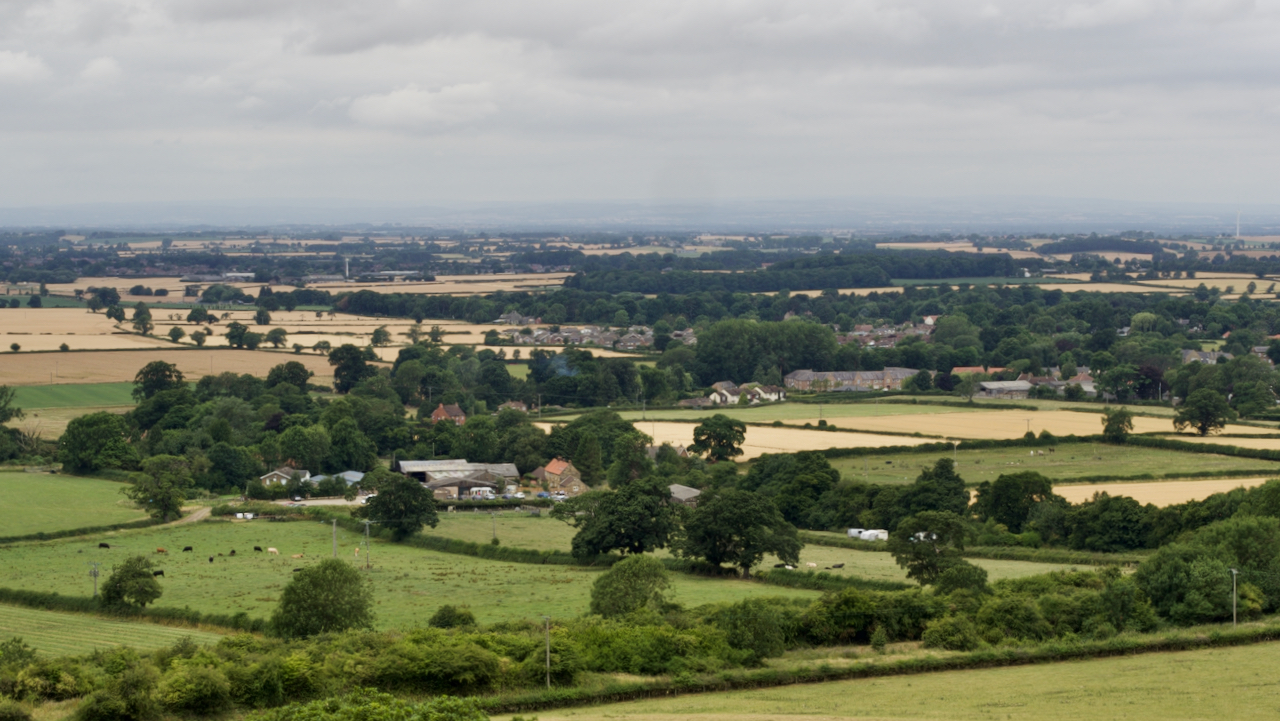I suppose most visitors to Great Ayton wouldn’t know where Little Ayton is. You best direct them to Fletcher’s Farm café and when they get there tell them they’ve passed through Little Ayton on the way.
It is an unimposing hamlet consisting of around a dozen farms or houses. The ‘centre’, I guess, would be where the road crosses the River Leven over the iron bridge. In the 19th-century there used to be a ford here1‘View Map: Yorkshire 29 (Includes: Easby; Great Ayton; Ingleby Greenhow; Kildale; Little Ay… – Ordnance Survey Six-Inch England and Wales, 1842-1952’. 2022. Maps.nls.uk <https://maps.nls.uk/view/102344245#zoom=7&lat=6350&lon=2973&layers=BT> [accessed 21 July 2022].
In the photo, Little Ayton is hidden amongst the trees left of centre. The buildings nearest belong to Woodhouse Farm (aka Fletcher’s Farm).
Little Ayton though has some ancient history. It is mentioned in the Domesday Book: “In alia Atun …” begins a record in much abbreviated medieval latin which I understand translates as “In the other Atun Aschil had two carucates of land for geld, where one plough can be. Robert has it, and it is waste. In King Edward’s time it was worth 10 shillings.”2o’Sullivan, Dan. “Great Ayton: A history of the village”. Page 26. 1983. ISBN 0 9508858 0 0.
A ‘carucate’ was typically an area of about 120 acres or the amount of land a team of eight oxen could plough in a year. But ‘carucates for geld’ was a tax assessment of the cultivated land twenty years earlier, i.e. 1066 on Edward the Confessor’s death3Ibid..
What this reveals is that for the Domesday Book, Little Ayton was valued as ‘waste‘, most likely as a result of the harrying of the north by King William4Ibid. Page 27. .
What I find intriguing is that there was once a chapel in Little Ayton. It was built in 1215 by Sir William Mallisse, but the abbot and monks of Whitby were quite protective of their privileges, and disapproved. Eventually though, the chapel was granted to Whitby Abbey, but there is no mention of it after 1244 so presumbly it was demolished5‘Heritage Gateway – NY SMR Number:
MNY12649’. 2012. Heritagegateway.org.uk <https://www.heritagegateway.org.uk/Gateway/Results_Single.aspx?uid=MNY12649&resourceID=1009> [accessed 21 July 2022]6Cook, Hugh. W. “Cleveland Re-Visited Great Ayton”. | Cleveland Standard | Saturday 19 November 1932 | British Newspaper Archive.” Available online at https://www.britishnewspaperarchive.co.uk/viewer/bl/0003490/19321119/166/0010. [Accessed 20 July 2022].7‘Parishes: Great Ayton | British History Online’. 2022. British-History.ac.uk <https://www.british-history.ac.uk/vch/yorks/north/vol2/pp225-231#h3-0004> [accessed 21 July 2022].
When I first read about this chapel, my first thoughts were that it was contemporary with the Chapel of St Hilda at Kildale the Hidden Valley Community Project are currently excavating which is thought to date from between 1235 to 1257 when Sir William de Percy gave an existing chapel to the canons of Healaugh Park Priory. So possibly contemporaneous.
- 1‘View Map: Yorkshire 29 (Includes: Easby; Great Ayton; Ingleby Greenhow; Kildale; Little Ay… – Ordnance Survey Six-Inch England and Wales, 1842-1952’. 2022. Maps.nls.uk <https://maps.nls.uk/view/102344245#zoom=7&lat=6350&lon=2973&layers=BT> [accessed 21 July 2022]
- 2o’Sullivan, Dan. “Great Ayton: A history of the village”. Page 26. 1983. ISBN 0 9508858 0 0.
- 3Ibid.
- 4Ibid. Page 27.
- 5‘Heritage Gateway – NY SMR Number:
MNY12649’. 2012. Heritagegateway.org.uk <https://www.heritagegateway.org.uk/Gateway/Results_Single.aspx?uid=MNY12649&resourceID=1009> [accessed 21 July 2022] - 6Cook, Hugh. W. “Cleveland Re-Visited Great Ayton”. | Cleveland Standard | Saturday 19 November 1932 | British Newspaper Archive.” Available online at https://www.britishnewspaperarchive.co.uk/viewer/bl/0003490/19321119/166/0010. [Accessed 20 July 2022].
- 7‘Parishes: Great Ayton | British History Online’. 2022. British-History.ac.uk <https://www.british-history.ac.uk/vch/yorks/north/vol2/pp225-231#h3-0004> [accessed 21 July 2022]

Leave a Reply